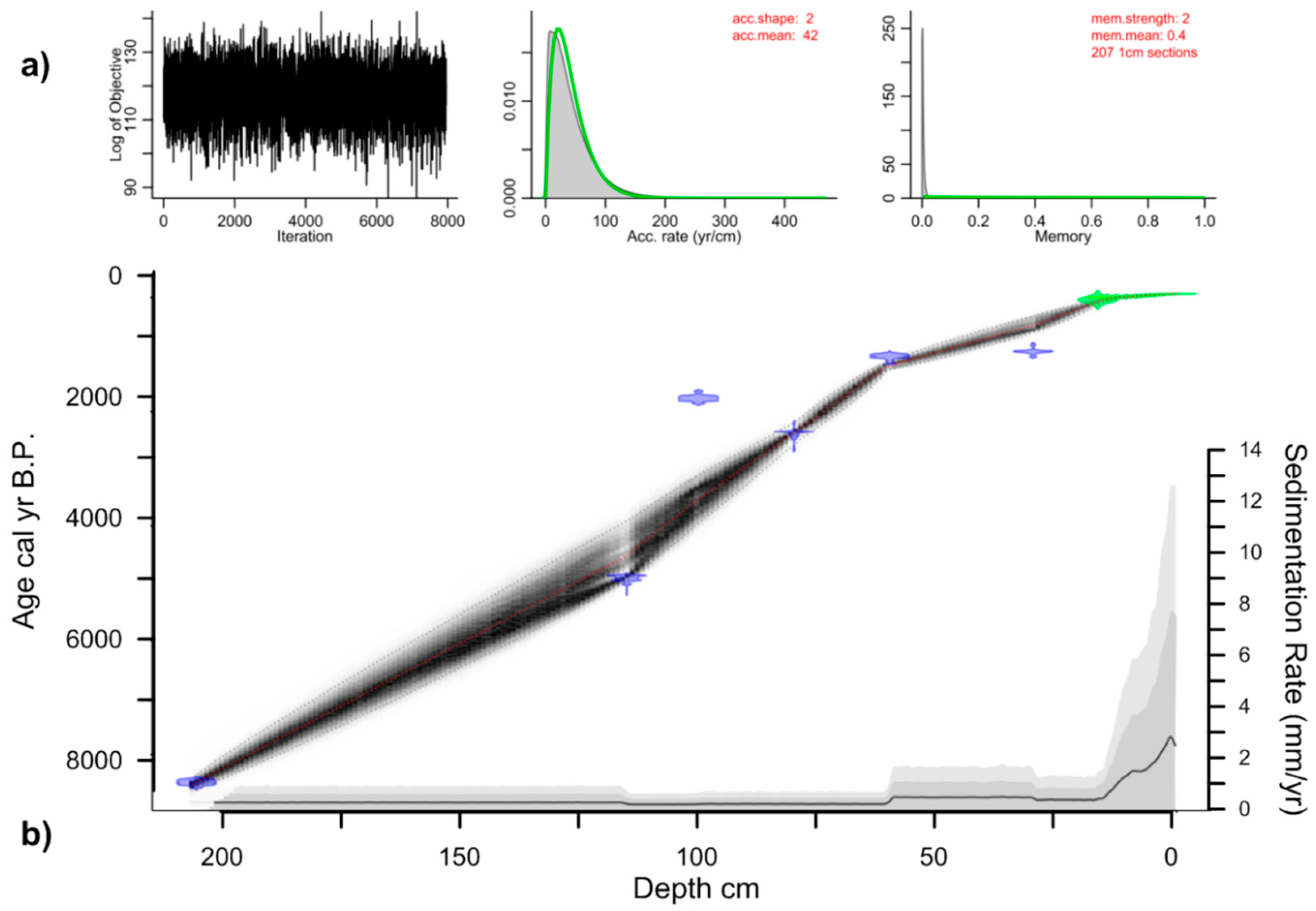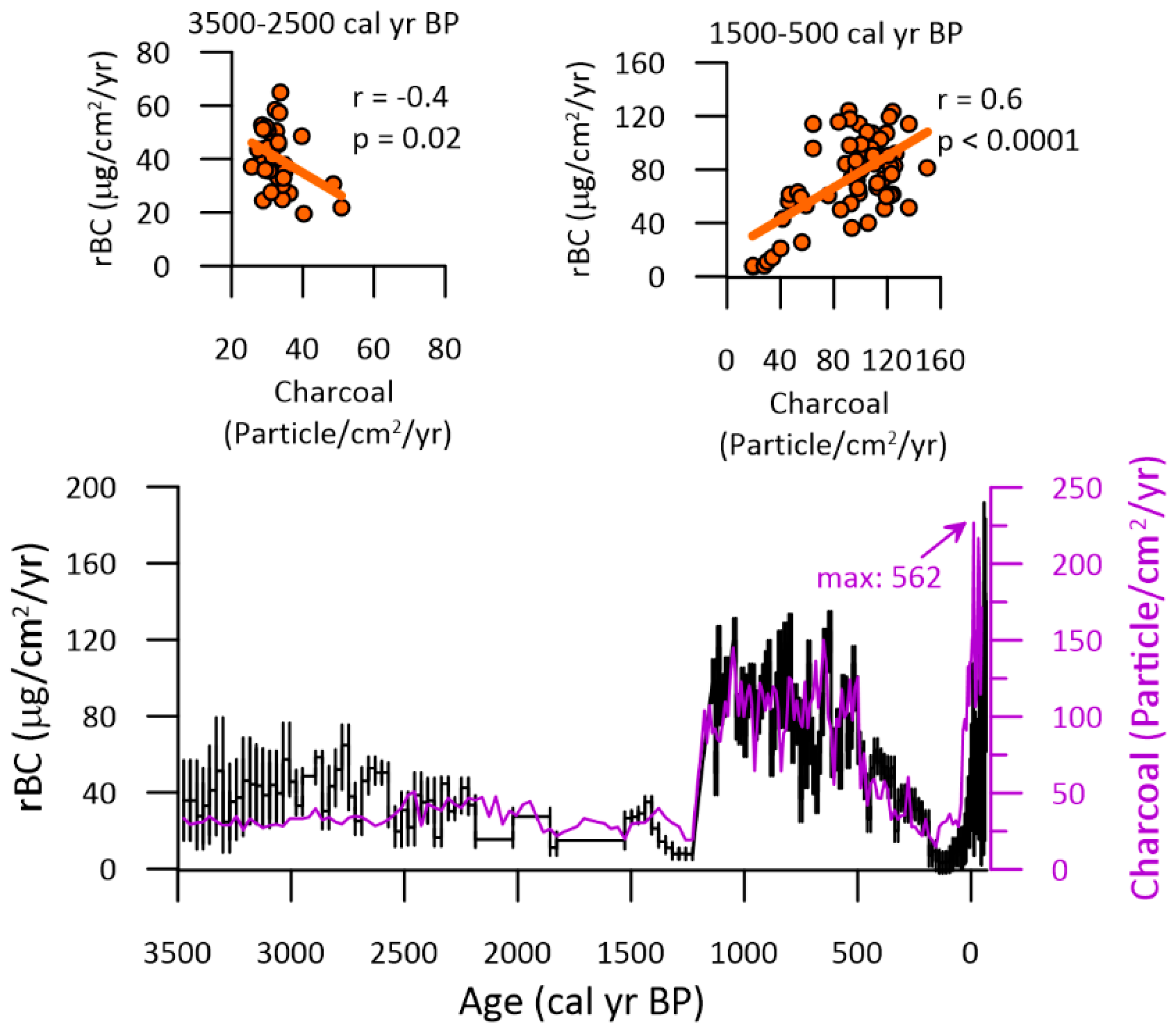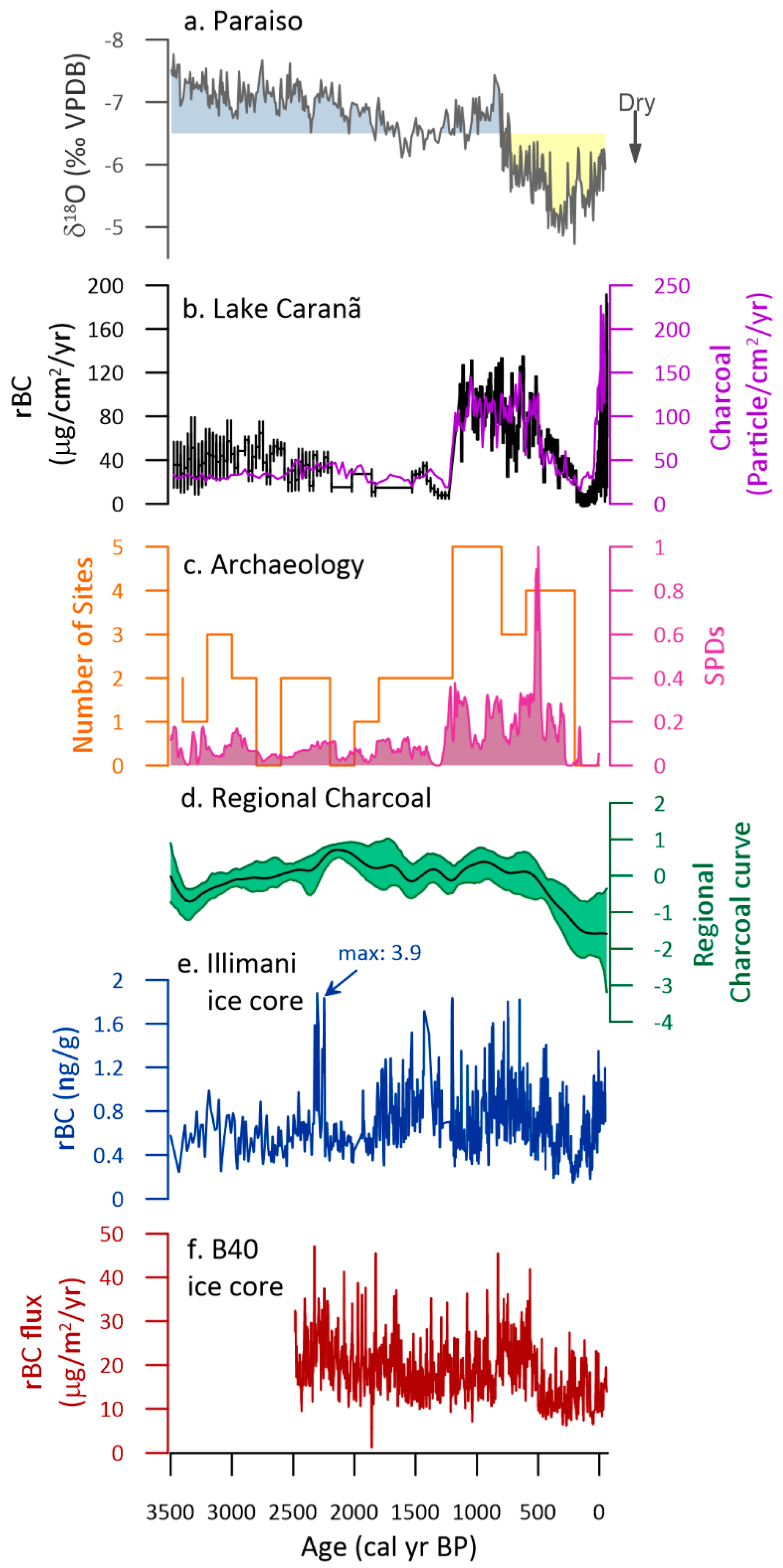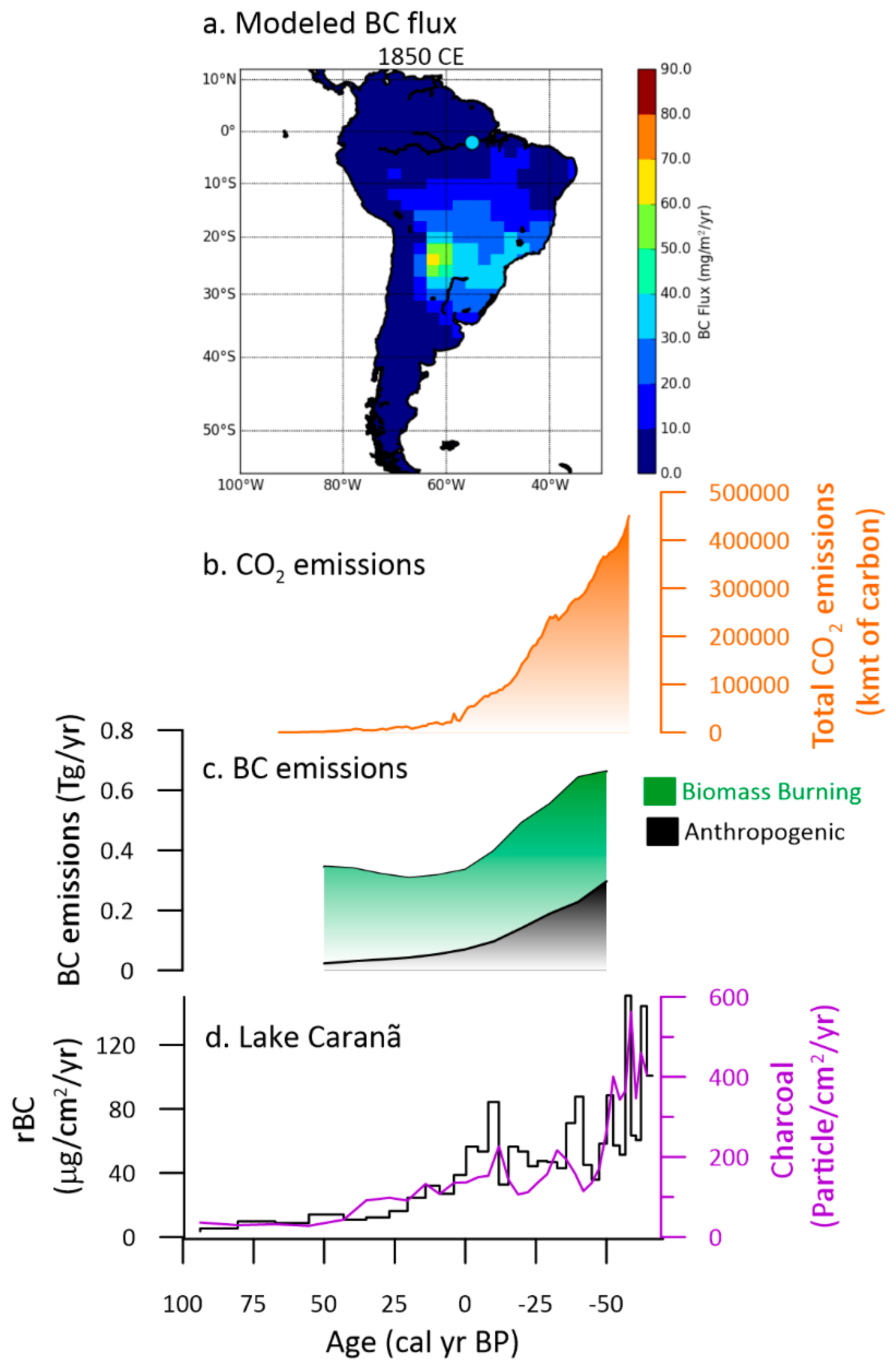Pre-Columbian Fire Management Linked to Refractory Black Carbon Emissions in the Amazon
Abstract
1. Introduction
2. Materials and Methods
2.1. Study Site
2.2. Age–Depth Model
2.3. Macrocharcoal
2.4. Sum of the Calibrated Probability Distributions (SPDs) and Site Frequencies
2.5. Regional Charcoal Curve
2.6. Refractory Black Carbon
3. Results
Refractory Black Carbon and Macrocharcoal
4. Discussion
4.1. Local Biomass Burning and rBC Emissions
4.2. Climate and Biomass Burning
4.3. Modern Black Carbon Emission Sources
4.4. Future Implications for rBC Production
5. Conclusions
Supplementary Materials
Author Contributions
Funding
Acknowledgments
Conflicts of Interest
References
- Costafreda-Aumedes, S.; Comas, C.; Vega-Garcia, C. Human-caused fire occurrence modelling in perspective: A review. Int. J. Wildl. Fire 2017, 26, 983–998. [Google Scholar] [CrossRef]
- Aragao, L.; Anderson, L.; Fonseca, M.; Rosan, T.; Vedovato, L.; Wagner, F.; Silva, C.; Silva, C.; Arai, E.; Aguiar, A.; et al. 21st Century drought-related fires counteract the decline of Amazon deforestation carbon emissions. Nat. Commun. 2018, 9. [Google Scholar] [CrossRef] [PubMed]
- Baccini, A.; Walker, W.; Carvalho, L.; Farina, M.; Sulla-Menashe, D.; Houghton, R. Tropical forests are a net carbon source based on aboveground measurements of gain and loss. Science 2017, 358, 230–233. [Google Scholar] [CrossRef] [PubMed]
- De Faria, B.; Brando, P.; Macedo, M.; Panday, P.; Soares, B.; Coe, M. Current and future patterns of fire-induced forest degradation in Amazonia. Environ. Res. Lett. 2017, 12. [Google Scholar] [CrossRef]
- Bond, T.; Doherty, S.; Fahey, D.; Forster, P.; Berntsen, T.; DeAngelo, B.; Flanner, M.; Ghan, S.; Karcher, B.; Koch, D.; et al. Bounding the role of black carbon in the climate system: A scientific assessment. J. Geophys. Res.-Atmos. 2013, 118, 5380–5552. [Google Scholar] [CrossRef]
- McConnell, J.; Edwards, R.; Kok, G.; Flanner, M.; Zender, C.; Saltzman, E.; Banta, J.; Pasteris, D.; Carter, M.; Kahl, J. 20th-century industrial black carbon emissions altered Arctic climate forcing. Science 2007, 317, 1381–1384. [Google Scholar] [CrossRef] [PubMed]
- Painter, T.; Flanner, M.; Kaser, G.; Marzeion, B.; VanCuren, R.; Abdalati, W. End of the Little Ice Age in the Alps forced by industrial black carbon. Proc. Natl. Acad. Sci. USA 2013, 110, 15216–15221. [Google Scholar] [CrossRef] [PubMed]
- Bond, T.; Bhardwaj, E.; Dong, R.; Jogani, R.; Jung, S.; Roden, C.; Streets, D.; Trautmann, N. Historical emissions of black and organic carbon aerosol from energy-related combustion, 1850–2000. Glob. Biogeochem. Cycle 2007, 21. [Google Scholar] [CrossRef]
- Lamarque, J.; Bond, T.; Eyring, V.; Granier, C.; Heil, A.; Klimont, Z.; Lee, D.; Liousse, C.; Mieville, A.; Owen, B.; et al. Historical (1850-2000) gridded anthropogenic and biomass burning emissions of reactive gases and aerosols: Methodology and application. Atmos. Chem. Phys. 2010, 10, 7017–7039. [Google Scholar] [CrossRef]
- IPCC. Part A: Global and Sectoral Aspects: Working Group II Contribution to the IPCC Fifth Assessment Report. In Climate Change 2014 – Impacts, Adaptation and Vulnerability: Volume 1: Global and Sectoral Aspects; Intergovernmental Panel on Climate, C., Ed.; Cambridge University Press: Cambridge, UK, 2014; Volume 1, pp. i–ii. [Google Scholar]
- Arienzo, M.; McConnell, J.; Murphy, L.; Chellman, N.; Das, S.; Kipfstuhl, S.; Mulvaney, R. Holocene black carbon in Antarctica paralleled Southern Hemisphere climate. J. Geophys. Res.-Atmos. 2017, 122, 6713–6728. [Google Scholar] [CrossRef]
- Osmont, D.; Sigl, M.; Eichler, A.; Jenk, T.M.; Schwikowski, M. A Holocene black carbon ice-core record of biomass burning in the Amazon Basin from Illimani, Bolivia. Clim. Past 2019, 15, 579–592. [Google Scholar] [CrossRef]
- Zennaro, P.; Kehrwald, N.; McConnell, J.R.; Schuepbach, S.; Maselli, O.J.; Marlon, J.; Vallelonga, P.; Leuenberger, D.; Zangrando, R.; Spolaor, A.; et al. Fire in ice: Two millennia of boreal forest fire history from the Greenland NEEM ice core. Clim. Past 2014, 10, 1905–1924. [Google Scholar] [CrossRef]
- Han, Y.M.; Cao, J.J.; Yan, B.Z.; Kenna, T.C.; Jin, Z.D.; Cheng, Y.; Chow, J.C.; An, Z.S. Comparison of elemental carbon in lake sediments measured by three different methods and 150-year pollution history in eastern China. Environ. Sci. Technol. 2011, 45, 5287–5293. [Google Scholar] [CrossRef] [PubMed]
- Cordeiro, R.; Turcq, B.; Ribeiro, M.; Lacerda, L.; Capitaneo, J.; da Silva, A.; Sifeddine, A.; Turcq, P. Forest fire indicators and mercury deposition in an intense land use change region in the Brazilian Amazon (Alta Floresta, MT). Sci. Total Environ. 2002, 293, 247–256. [Google Scholar] [CrossRef]
- Schmitt, C.; All, J.; Schwarz, J.; Arnott, W.; Cole, R.; Lapham, E.; Celestian, A. Measurements of light-absorbing particles on the glaciers in the Cordillera Blanca, Peru. Cryosphere 2015, 9, 331–340. [Google Scholar] [CrossRef]
- Rowe, P.M.; Cordero, R.R.; Warren, S.G.; Stewart, E.; Doherty, S.J.; Pankow, A.; Schrempf, M.; Casassa, G.; Carrasco, J.; Pizarro, J.; et al. Black carbon and other light-absorbing impurities in snow in the Chilean Andes. Sci. Rep. 2019, 9, 4008. [Google Scholar] [CrossRef] [PubMed]
- Flanner, M.; Zender, C.; Randerson, J.; Rasch, P. Present-day climate forcing and response from black carbon in snow. J. Geophys. Res.-Atmos. 2007, 112. [Google Scholar] [CrossRef]
- Macdonald, K.; Sharma, S.; Toom, D.; Chivulescu, A.; Platt, A.; Elsasser, M.; Huang, L.; Leaitch, R.; Chellman, N.; McConnell, J.; et al. Temporally delineated sources of major chemical species in high Arctic snow. Atmos. Chem. Phys. 2018, 18, 3485–3503. [Google Scholar] [CrossRef]
- Evangelista, H.; Maldonado, J.; Godoi, R.; Pereira, E.; Koch, D.; Tanizaki-Fonseca, K.; Van Grieken, R.; Sampaio, M.; Setzer, A.; Alencar, A.; et al. Sources and transport of urban and biomass burning aerosol black carbon at the South-West Atlantic coast. J. Atmos. Chem. 2007, 56, 225–238. [Google Scholar] [CrossRef]
- Artaxo, P.; Fernandes, E.; Martins, J.; Yamasoe, M.; Hobbs, P.; Maenhaut, W.; Longo, K.; Castanho, A. Large-scale aerosol source apportionment in Amazonia. J. Geophys. Res.-Atmos. 1998, 103, 31837–31847. [Google Scholar] [CrossRef]
- Maezumi, S.; Whitney, B.; Mayle, F.; de Souza, J.; Iriarte, J. Reassessing climate and pre-Columbian drivers of paleofire activity in the Bolivian Amazon. Quat. Int. 2018, 488, 81–94. [Google Scholar] [CrossRef]
- McMichael, C.; Feeley, K.; Dick, C.; Piperno, D.; Bush, M. Comment on “Persistent effects of pre-Columbian plant domestication on Amazonian forest composition”. Science 2017, 358. [Google Scholar] [CrossRef] [PubMed]
- McMichael, C.N.H.; Bush, M.B. Spatiotemporal patterns of pre-Columbian people in Amazonia. Quat. Res. 2019, 1–17. [Google Scholar] [CrossRef]
- Bush, M.; Silman, M.; Listopad, C. A regional study of Holocene climate change and human occupation in Peruvian Amazonia. J. Biogeogr. 2007, 34, 1342–1356. [Google Scholar] [CrossRef]
- Iriarte, J.; Power, M.; Rostain, S.; Mayle, F.; Jones, H.; Watling, J.; Whitney, B.; Mckey, D. Fire-free land use in pre-1492 Amazonian savannas. Proc. Natl. Acad. Sci. USA 2012, 109, 6473–6478. [Google Scholar] [CrossRef] [PubMed]
- Carson, J.; Whitney, B.; Mayle, F.; Iriarte, J.; Prumers, H.; Soto, J.; Watling, J. Environmental impact of geometric earthwork construction in pre-Columbian Amazonia. Proc. Natl. Acad. Sci. USA 2014, 111, 10497–10502. [Google Scholar] [CrossRef] [PubMed]
- Mayle, F.; Iriarte, J. Integrated palaeoecology and archaeology - a powerful approach for understanding pre-Columbian Amazonia. J. Archaeol. Sci. 2014, 51, 54–64. [Google Scholar] [CrossRef]
- McMichael, C.; Piperno, D.; Bush, M.; Silman, M.; Zimmerman, A.; Raczka, M.; Lobato, L. Sparse Pre-Columbian Human Habitation in Western Amazonia. Science 2012, 336, 1429–1431. [Google Scholar] [CrossRef]
- Piperno, D.R. Phytoliths: A Comprehensive Guide for Archaeologists and Paleoecologists; Rowman Altamira: Lanham, MD, USA, 2006. [Google Scholar]
- Clement, C.; Cristo-Araújo, D.; Coppens D’Eeckenbrugge, G.; Alves Pereira, A.; Picanço-Rodrigues, D. Origin and domestication of native Amazonian crops. Diversity 2010, 2, 72–106. [Google Scholar] [CrossRef]
- Thomas, E.; Alcázar Caicedo, C.; McMichael, C.H.; Corvera, R.; Loo, J. Uncovering spatial patterns in the natural and human history of Brazil nut (Bertholletia excelsa) across the Amazon Basin. J. Biogeogr. 2015, 42, 1367–1382. [Google Scholar] [CrossRef]
- Whitney, B.S.; Dickau, R.; Mayle, F.E.; Walker, J.H.; Soto, J.D.; Iriarte, J. Pre-Columbian raised-field agriculture and land use in the Bolivian Amazon. Holocene 2014, 24, 231–241. [Google Scholar] [CrossRef]
- Bush, M.; McMichael, C.; Piperno, D.; Silman, M.; Barlow, J.; Peres, C.; Power, M.; Palace, M. Anthropogenic influence on Amazonian forests in pre-history: An ecological perspective. J. Biogeogr. 2015, 42, 2277–2288. [Google Scholar] [CrossRef]
- Urrego, D.; Bush, M.; Silman, M.; Niccum, B.; De La Rosa, P.; McMichael, C.; Hagen, S.; Palace, M. Holocene fires, forest stability and human occupation in south-western Amazonia. J. Biogeogr. 2013, 40, 521–533. [Google Scholar] [CrossRef]
- Loughlin, N.; Gosling, W.; Mothes, P.; Montoya, E. Ecological consequences of post-Columbian indigenous depopulation in the Andean-Amazonian corridor. Nat. Ecol. Evol. 2018, 2, 1233–1236. [Google Scholar] [CrossRef] [PubMed]
- Bush, M.; Correa-Metrio, A.; McMichael, C.; Sully, S.; Shadik, C.; Valencia, B.; Guilderson, T.; Steinitz-Kannan, M.; Overpeck, J. A 6900-year history of landscape modification by humans in lowland Amazonia. Quat. Sci. Rev. 2016, 141, 52–64. [Google Scholar] [CrossRef]
- Watling, J.; Iriarte, J.; Mayle, F.; Schaan, D.; Pessenda, L.; Loader, N.; Street-Perrott, F.; Dickau, R.; Damasceno, A.; Ranzi, A. Impact of pre-Columbian "geoglyph" builders on Amazonian forests. Proc. Natl. Acad. Sci. USA 2017, 114, 1868–1873. [Google Scholar] [CrossRef] [PubMed]
- Brugger, S.; Gobet, E.; van Leeuwen, J.; Ledru, M.; Colombaroli, D.; van der Knaap, W.; Lombardo, U.; Escobar-Torrez, K.; Finsinger, W.; Rodrigues, L.; et al. Long-term man-environment interactions in the Bolivian Amazon: 8000 years of vegetation dynamics. Quat. Sci. Rev. 2016, 132, 114–128. [Google Scholar] [CrossRef]
- Irion, G.; Bush, M.; de Mello, J.; Stuben, D.; Neumann, T.; Muller, G.; De, J.; Junk, J. A multiproxy palaeoecological record of Holocene lake sediments from the Rio Tapajos, eastern Amazonia. Palaeogeogr. Palaeoclimatol. Palaeoecol. 2006, 240, 523–535. [Google Scholar] [CrossRef]
- Maezumi, S.; Robinson, M.; de Souza, J.; Urrego, D.; Schaan, D.; Alves, D.; Iriarte, J. New Insights From Pre-Columbian Land Use and Fire Management in Amazonian Dark Earth Forests. Front. Ecol. Evol. 2018, 6. [Google Scholar] [CrossRef]
- Maezumi, S.; Alves, D.; Robinson, M.; de Souza, J.; Levis, C.; Barnett, R.; de Oliveira, E.; Urrego, D.; Schaan, D.; Iriarte, J. The legacy of 4,500 years of polyculture agroforestry in the eastern Amazon. Nat. Plants 2018, 4, 540–547. [Google Scholar] [CrossRef]
- Higuera, P.; Peters, M.; Brubaker, L.; Gavin, D. Understanding the origin and analysis of sediment-charcoal records with a simulation model. Quat. Sci. Rev. 2007, 26, 1790–1809. [Google Scholar] [CrossRef]
- Peters, M.; Higuera, P. Quantifying the source area of macroscopic charcoal with a particle dispersal model. Quat. Res. 2007, 67, 304–310. [Google Scholar] [CrossRef]
- Brown, K.J.; Power, M.J. Charred particle analyses. In The Encyclopedia of Quaternary Science; Elias, S.A., Ed.; Elsevier: Amsterdam, The Netherlands, 2013; Volume 2, pp. 716–729. [Google Scholar]
- Marlon, J.; Bartlein, P.J.; Daniau, A.-L.; Harrison, S.P.; Maezumi, S.Y.; Power, M.J.; Tinner, W.; Vanniere, B. Global biomass burning: A synthesis and review of Holocene paleofire records and their controls. Quat. Sci. Rev. 2013, 65, 5–25. [Google Scholar] [CrossRef]
- Power, M.; Marlon, J.; Bartlein, P.; Harrison, S. Fire history and the Global Charcoal Database: A new tool for hypothesis testing and data exploration. Palaeogeogr. Palaeoclimatol. Palaeoecol. 2010, 291, 52–59. [Google Scholar] [CrossRef]
- Power, M.J.; Bush, M.B.; Behling, H.; Horn, S.P.; Mayle, F.E.; Urrego, D.H. Paleofire activity in tropical America during the last 21 ka: A regional synthesis based on sedimentary charcoal. PAGES Newsl. 2010, 18, 73–75. [Google Scholar] [CrossRef]
- Whitlock, C.; Larsen, C. Charcoal as a fire proxy. In Tracking Environmental Change Using Lake Sediments; Last, W.M., Smol, J.P., Eds.; Springer: Dordrecht, The Netherlands, 2002; pp. 75–97. [Google Scholar]
- Marlon, J.; Bartlein, P.J.; Carcaillet, C.; Gavin, D.G.; Harrison, S.P.; Higuera, P.E.; Joos, F.; Power, M.J.; Prentice, I.C. Climate and human influences on global biomass burning over the past two millennia. Nat. Geosci. 2008, 1, 697–702. [Google Scholar] [CrossRef]
- Power, M.J.; Marlon, J.; Ortiz, N.; Bartlein, P.J.; Harrison, S.P.; Mayle, F.E.; Ballouche, A.; Bradshaw, R.H.W.; Carcaillet, C.; Cordova, C.; et al. Changes in fire regimes since the Last Glacial Maximum: an assessment based on a global synthesis and analysis of charcoal data. Clim. Dyn. 2008, 30, 887–907. [Google Scholar] [CrossRef]
- Chellman, N.; McConnell, J.; Heyvaert, A.; Vanniere, B.; Arienzo, M.; Wennrich, V. Incandescence-based single-particle method for black carbon quantification in lake sediment cores. Limnol. Oceanogr.-Methods 2018, 16, 711–721. [Google Scholar] [CrossRef]
- Leys, B.; Brewer, S.C.; McConaghy, S.; Mueller, J.; McLauchlan, K.K. Fire history reconstruction in grassland ecosystems: amount of charcoal reflects local area burned. Environ. Res. Lett. 2015, 10, 114009. [Google Scholar] [CrossRef]
- Wang, X.; Edwards, R.; Auler, A.; Cheng, H.; Kong, X.; Wang, Y.; Cruz, F.; Dorale, J.; Chiang, H. Hydroclimate changes across the Amazon lowlands over the past 45,000 years. Nature 2017, 541, 204–207. [Google Scholar] [CrossRef]
- Vuille, M.; Werner, M. Stable isotopes in precipitation recording South American summer monsoon and ENSO variability: observations and model results. Clim. Dyn. 2005, 25, 401–413. [Google Scholar] [CrossRef]
- Ramanathan, V.; Carmichael, G. Global and regional climate changes due to black carbon. Nat. Geosci. 2008, 1, 221–227. [Google Scholar] [CrossRef]
- Appleby, P.G. Chronostratigraphic techniques in recent sediments. In Tracking Environmental Change Using Lake Sediments; Last, W.M., Smol, J.P., Eds.; Springer: Dordrecht, The Netherlands, 2002; pp. 171–203. [Google Scholar]
- Blaauw, M.; Christen, J.; Mauquoy, D.; van der Plicht, J.; Bennett, K. Testing the timing of radiocarbon-dated events between proxy archives. Holocene 2007, 17, 283–288. [Google Scholar] [CrossRef]
- R Core Team. R: A Language and Environment for Statistical Computing; R Core Team: Vienna, Austria, 2013. [Google Scholar]
- Jensen, K.; Lynch, E.; Calcote, R.; Hotchkiss, S. Interpretation of charcoal morphotypes in sediments from Ferry Lake, Wisconsin, USA: do different plant fuel sources produce distinctive charcoal morphotypes? Holocene 2007, 17, 907–915. [Google Scholar] [CrossRef]
- Tweiten, M.; Hotchkiss, S.; Booth, R.; Calcote, R.; Lynch, E. The response of a jack pine forest to late-Holocene climate variability in northwestern Wisconsin. Holocene 2009, 19, 1049–1061. [Google Scholar] [CrossRef]
- Shennan, S.; Downey, S.; Timpson, A.; Edinborough, K.; Colledge, S.; Kerig, T.; Manning, K.; Thomas, M. Regional population collapse followed initial agriculture booms in mid-Holocene Europe. Nat. Commun. 2013, 4. [Google Scholar] [CrossRef] [PubMed]
- Timpson, A.; Colledge, S.; Crema, E.; Edinborough, K.; Kerig, T.; Manning, K.; Thomas, M.; Shennan, S. Reconstructing regional population fluctuations in the European Neolithic using radiocarbon dates: a new case-study using an improved method. J. Archaeol. Sci. 2014, 52, 549–557. [Google Scholar] [CrossRef]
- Reimer, P.J.; Bard, E.; Bayliss, A.; Beck, J.W.; Blackwell, P.G.; Ramsey, C.B.; Buck, C.E.; Cheng, H.; Edwards, R.L.; Friedrich, M. IntCal13 and Marine13 radiocarbon age calibration curves 0–50,000 years cal BP. Radiocarbon 2013, 55, 1869–1887. [Google Scholar] [CrossRef]
- Ramsey, C.B.; Lee, S. Recent and planned developments of the program OxCal. Radiocarbon 2013, 55, 720–730. [Google Scholar] [CrossRef]
- Goldberg, A.; Mychajliw, A.; Hadly, E. Post-invasion demography of prehistoric humans in South America. Nature 2016. [Google Scholar] [CrossRef] [PubMed]
- De Toledo, M.B.; Bush, M.B. A mid-Holocene environmental change in Amazonian savannas. J. Biogeogr. 2007, 34, 1313–1326. [Google Scholar] [CrossRef]
- Blarquez, O.; Vanniere, B.; Marlon, J.; Daniau, A.; Power, M.; Brewer, S.; Bartlein, P. paleofire: An R package to analyse sedimentary charcoal records from the Global Charcoal Database to reconstruct past biomass burning. Comput. Geosci. 2014, 72, 255–261. [Google Scholar] [CrossRef]
- Bush, M.; Miller, M.; De Oliveira, P.; Colinvaux, P. Two histories of environmental change and human disturbance in eastern lowland Amazonia. Holocene 2000, 10, 543–553. [Google Scholar] [CrossRef]
- Behling, H.; da Costa, M.L. Holocene vegetational and coastal environmental changes from the Lago Crispim record in northeastern Pará State, eastern Amazonia. Rev. Palaeobot. Palynol. 2001, 114, 145–155. [Google Scholar] [CrossRef]
- Behling, H.; da Costa, M.L. Holocene environmental changes from the Rio Curuá record in the Caxiuanã region, eastern Amazon Basin. Quat. Res. 2000, 53, 369–377. [Google Scholar] [CrossRef]
- Behling, H. Late Quaternary environmental changes in the Lagoa da Curuca region (eastern Amazonia, Brazil) and evidence of Podocarpus in the Amazon lowland. Veg. Hist. Archaeobot. 2001, 10, 175–183. [Google Scholar] [CrossRef]
- Bush, M.; Silman, M.; de Toledo, M.; Listopad, C.; Gosling, W.; Williams, C.; de Oliveira, P.; Krisel, C. Holocene fire and occupation in Amazonia: records from two lake districts. Phil. Trans. R. Soc. B-Biol. Sci. 2007, 362, 209–218. [Google Scholar] [CrossRef] [PubMed]
- Ohata, S.; Moteki, N.; Schwarz, J.; Fahey, D.; Kondo, Y. Evaluation of a Method to Measure Black Carbon Particles Suspended in Rainwater and Snow Samples. Aerosol Sci. Technol. 2013, 47, 1073–1082. [Google Scholar] [CrossRef]
- Schwarz, J.; Gao, R.; Fahey, D.; Thomson, D.; Watts, L.; Wilson, J.; Reeves, J.; Darbeheshti, M.; Baumgardner, D.; Kok, G.; et al. Single-particle measurements of midlatitude black carbon and light-scattering aerosols from the boundary layer to the lower stratosphere. J. Geophys. Res.-Atmos. 2006, 111. [Google Scholar] [CrossRef]
- Adolf, C.; Wunderle, S.; Colombaroli, D.; Weber, H.; Gobet, E.; Heiri, O.; van Leeuwen, J.; Bigler, C.; Connor, S.; Galka, M.; et al. The sedimentary and remote-sensing reflection of biomass burning in Europe. Glob. Ecol. Biogeogr. 2018, 27, 199–212. [Google Scholar] [CrossRef]
- Denevan, W.M. Estimating Amazonian Indian numbers in 1492. J. Latin Am. Geogr. 2014, 207–221. [Google Scholar] [CrossRef]
- Koch, A.; Brierley, C.; Maslin, M.M.; Lewis, S.L. Earth system impacts of the European arrival and Great Dying in the Americas after 1492. Quat. Sci. Rev. 2019, 207, 13–36. [Google Scholar] [CrossRef]
- Mann, M.E.; Zhang, Z.; Rutherford, S.; Bradley, R.S.; Hughes, M.K.; Shindell, D.; Ammann, C.; Faluvegi, G.; Ni, F. Global signatures and dynamical origins of the Little Ice Age and Medieval Climate Anomaly. Science 2009, 326, 1256–1260. [Google Scholar] [CrossRef] [PubMed]
- Dull, R.A.; Nevle, R.J.; Woods, W.I.; Bird, D.K.; Avnery, S.; Denevan, W.M. The Columbian encounter and the Little Ice Age: Abrupt land use change, fire, and greenhouse forcing. Ann. Assoc. Am. Geogr. 2010, 100, 755–771. [Google Scholar] [CrossRef]
- Nevle, R.; Bird, D.; Ruddiman, W.; Dull, R. Neotropical human-landscape interactions, fire, and atmospheric CO2 during European conquest. Holocene 2011, 21, 853–864. [Google Scholar] [CrossRef]
- Eichler, A.; Gramlich, G.; Kellerhals, T.; Tobler, L.; Schwikowski, M. Pb pollution from leaded gasoline in South America in the context of a 2000-year metallurgical history. Sci. Adv. 2015, 1. [Google Scholar] [CrossRef] [PubMed]
- Strosnider, W.; Lopez, F.; Nairn, R. Acid mine drainage at Cerro Rico de Potosi I: unabated high-strength discharges reflect a five century legacy of mining. Environ. Earth Sci. 2011, 64, 899–910. [Google Scholar] [CrossRef]
- Molina, L.; Gallardo, L.; Andrade, M.; Baumgardner, D.; Borbor-Cordova, M.; Borquez, R.; Casassa, G.; Cereceda-Balic, F.; Dawidowski, L.; Garreaud, R.; et al. Pollution and its Impacts on the South American Cryosphere. Earths Future 2015, 3, 345–369. [Google Scholar] [CrossRef]
- Lee, Y.H.; Lamarque, J.F.; Flanner, M.G.; Jiao, C.; Shindell, D.T.; Berntsen, T.; Bisiaux, M.M.; Cao, J.; Collins, W.J.; Curran, M.; et al. Evaluation of preindustrial to present-day black carbon and its albedo forcing from Atmospheric Chemistry and Climate Model Intercomparison Project (ACCMIP) (vol 13, pg 2607, 2013). Atmos. Chem. Phys. 2013, 13, 6553–6554. [Google Scholar] [CrossRef][Green Version]
- Boden, T.A.; Marland, G.; Andres, R.J. Global, Regional, and National Fossil-Fuel CO2 Emissions; Carbon Dioxide Information Analysis Center, Oak Ridge National Laboratory, U.S. Department of Energy: Oak Ridge, TN, USA, 2011.
- Lasslop, G.; Coppola, A.I.; Voulgarakis, A.; Yue, C.; Veraverbeke, S. Influence of Fire on the Carbon Cycle and Climate. Curr. Clim. Chang. Rep. 2019, 1–12. [Google Scholar] [CrossRef]
- Chadwick, R.; Good, P.; Martin, G.; Rowell, D. Large rainfall changes consistently projected over substantial areas of tropical land. Nat. Clim. Chang. 2015. [Google Scholar] [CrossRef]
- Xu, L.; Wang, A.; Wang, D.; Wang, H. Hot Spots of Climate Extremes in the Future. J. Geophys. Res. Atmos. 2019. [Google Scholar] [CrossRef]
- Le Page, Y.; Morton, D.; Hartin, C.; Bond-Lamberty, B.; Pereira, J.; Hurtt, G.; Asrar, G. Synergy between land use and climate change increases future fire risk in Amazon forests. Earth Syst. Dyn. 2017, 8, 1237–1246. [Google Scholar] [CrossRef]
- Koch, D.; Schulz, M.; Kinne, S.; McNaughton, C.; Spackman, J.; Balkanski, Y.; Bauer, S.; Berntsen, T.; Bond, T.; Boucher, O.; et al. Evaluation of black carbon estimations in global aerosol models. Atmos. Chem. Phys. 2009, 9, 9001–9026. [Google Scholar] [CrossRef]





| Eastern Amazon | Latitude | Longitude | Reference |
|---|---|---|---|
| Lake Tapera | 0.13004 | −51.078 | [67] |
| Lake Marcio | 0.16377 | −51.062 | [67] |
| Lago Caranã | −2.8356 | −55.043 | [41,42] |
| Lake Comprida | −1.6249 | −54 | [69] |
| Lake Geral | −1.6469 | −53.596 | [69] |
| Lago Crispim | −0.6226 | −47.644 | [70] |
| Rio Curua | −1.7347 | −51.455 | [71] |
| Lagoa da Curuca | −0.7667 | −47.85 | [72] |
| Lake Saracuri | −1.6788 | −53.57 | [73] |
| Lake Santa Maria | −1.5783 | −53.605 | [73] |
| Lago Tapajos | −2.7758 | −55.083 | [73] |
© 2019 by the authors. Licensee MDPI, Basel, Switzerland. This article is an open access article distributed under the terms and conditions of the Creative Commons Attribution (CC BY) license (http://creativecommons.org/licenses/by/4.0/).
Share and Cite
Arienzo, M.M.; Maezumi, S.Y.; Chellman, N.J.; Iriarte, J. Pre-Columbian Fire Management Linked to Refractory Black Carbon Emissions in the Amazon. Fire 2019, 2, 31. https://doi.org/10.3390/fire2020031
Arienzo MM, Maezumi SY, Chellman NJ, Iriarte J. Pre-Columbian Fire Management Linked to Refractory Black Carbon Emissions in the Amazon. Fire. 2019; 2(2):31. https://doi.org/10.3390/fire2020031
Chicago/Turabian StyleArienzo, Monica M., S. Yoshi Maezumi, Nathan J. Chellman, and Jose Iriarte. 2019. "Pre-Columbian Fire Management Linked to Refractory Black Carbon Emissions in the Amazon" Fire 2, no. 2: 31. https://doi.org/10.3390/fire2020031
APA StyleArienzo, M. M., Maezumi, S. Y., Chellman, N. J., & Iriarte, J. (2019). Pre-Columbian Fire Management Linked to Refractory Black Carbon Emissions in the Amazon. Fire, 2(2), 31. https://doi.org/10.3390/fire2020031





